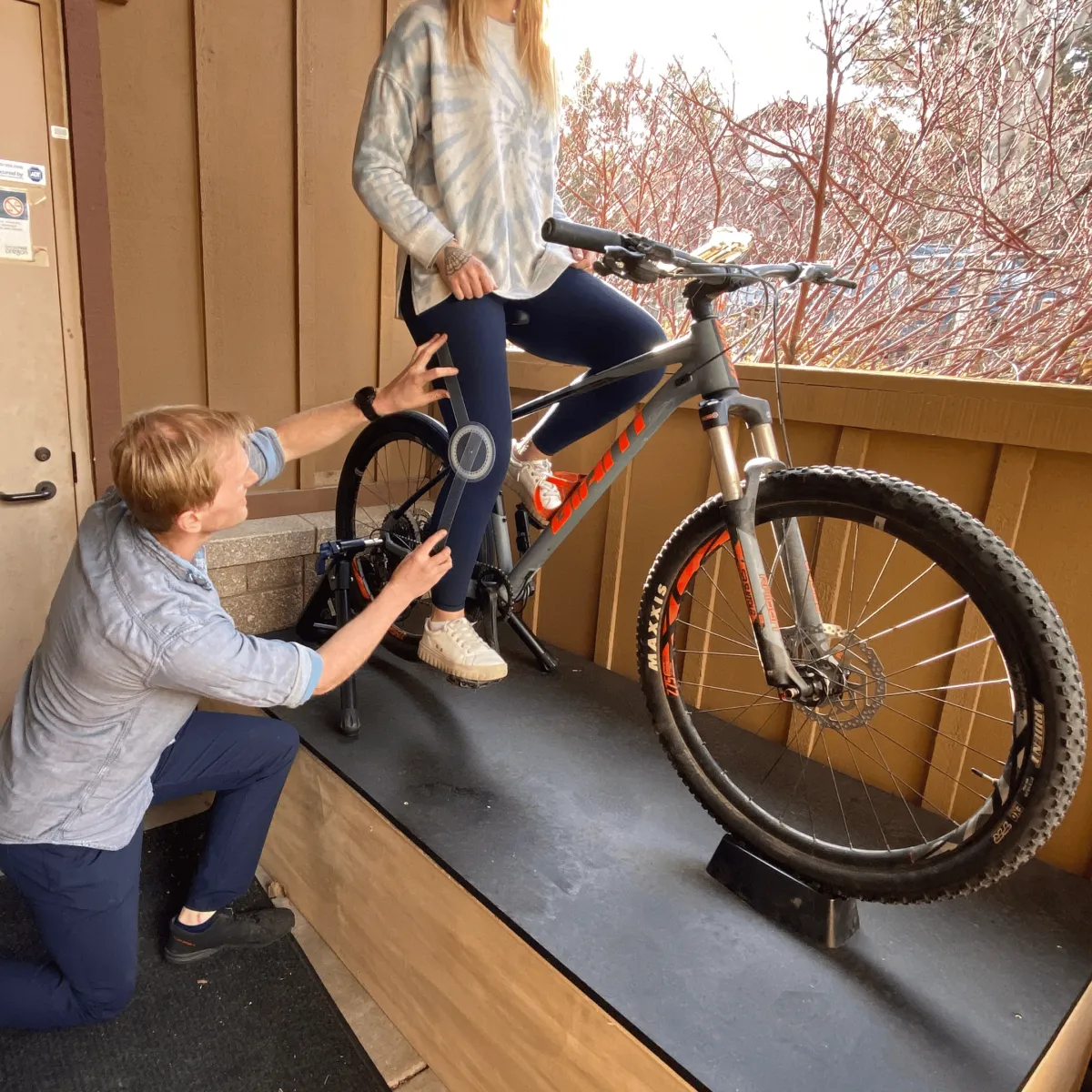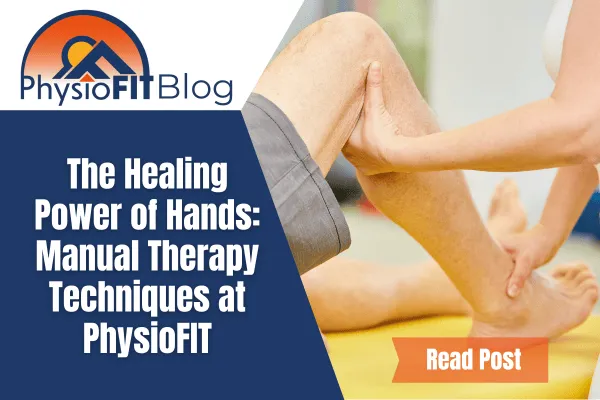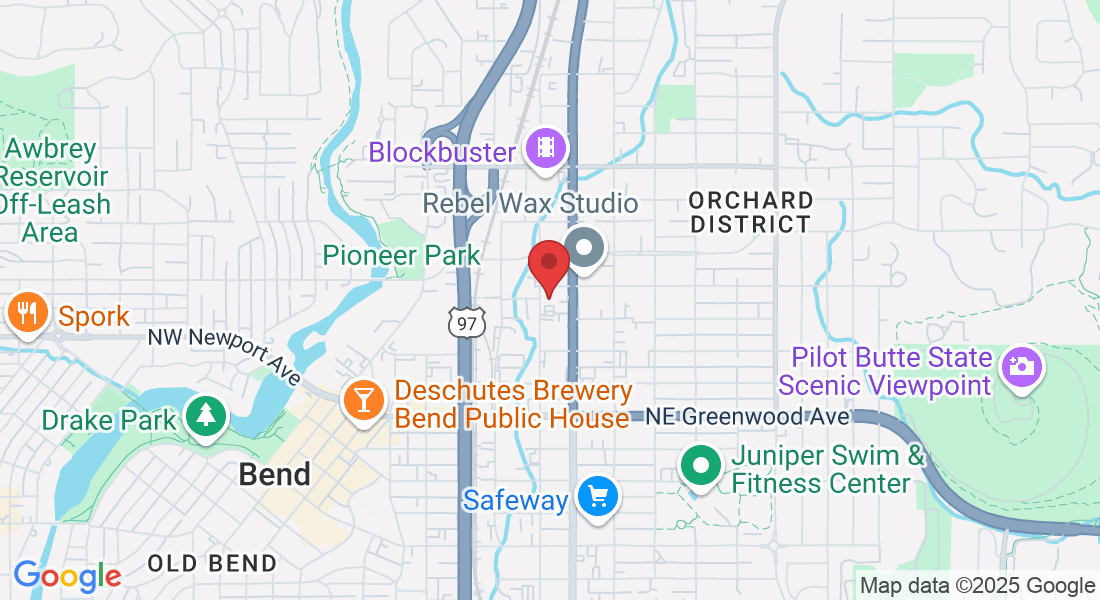Bike Fitting
Revolutionize Your Ride with a Bike Fitting at PhysioFIT
Welcome to PhysioFIT's bike fitting service, where your cycling experience is transformed. Our expert, Tanner Sommers, PT, DPT, brings unparalleled expertise in physical therapy and bike fitting to ensure you get the most out of every ride. Whether you're a seasoned athlete, a weekend warrior, or a daily commuter, our bike fitting service is tailored to meet your unique needs and goals.
Bike fittings at PhysioFIT are not just for professional athletes; they are for everyone who rides a bike. Our individualized approach caters to commuters, recreational riders, local athletes, triathletes, and mountain bikers. No matter your skill level or training background, a custom bike fitting can significantly enhance your riding experience.
The Many Benefits of a Proper Bike Fit
For Athletes: A proper bike fit significantly enhances athletic performance by aligning the rider's posture and bike mechanics to prevent injuries.
It optimizes the engagement of the right muscle groups, leading to increased power output and efficiency in pedaling, which is crucial for competitive cycling.
For Recreational Riders: Personalized bike fitting elevates the overall biking experience, ensuring greater comfort and enjoyment during rides.
It minimizes the likelihood of overuse injuries by correctly distributing the rider's weight and improving riding technique.
Riders receive valuable education on making adjustments to their bikes, which can provide immediate pain relief and prevent future discomfort.

What Does a Bike Fitting Involve?
Embarking on a bike fitting session at PhysioFIT is a comprehensive process designed to tailor your cycling experience to your body's unique requirements, lasting between 60 to 90 minutes. Led by the skilled hands of Tanner Sommers, PT, DPT, each session begins with a detailed assessment of your cycling goals, physical attributes, and any specific needs arising from unique conditions such as disabilities or the necessity for adaptive equipment.
Tanner employs a holistic approach, ensuring that the bike fitting transcends traditional measurements. He meticulously analyzes your biomechanics, considering factors like flexibility, limb length, and joint mobility, to customize the bike to your physiology. This customization is crucial not only for comfort but also for efficiency and power optimization during your ride.
Throughout the fitting, Tanner also provides personalized interventions that may include corrective exercises, stretches, or technique adjustments to enhance your cycling posture and prevent injuries. Moreover, he offers tailored education on how to maintain the ideal bike fit, addressing any concerns related to bicycle ergonomics. This education often encompasses guidance on self-assessment and making minor adjustments at home, ensuring your bike continues to fit perfectly as your body adapts and cycling proficiency evolves.
The fitting session is not just a one-time adjustment; it's an educational experience that empowers you with knowledge about your body's interaction with your bike. This session ultimately aims to address and alleviate any bicycle-related injuries or discomforts, ensuring that every journey you take is both enjoyable and ergonomically beneficial.
The Importance of a Regular Bike Fitting
Cycling is not a static sport – as you pedal forward, your body is also advancing in its capabilities and conditioning. This dynamic progression calls for an equally dynamic approach to how you fit your bicycle. Regular bike fittings are a cornerstone of maintaining peak performance and comfort. Here's why making bike fittings a regular part of your cycling routine is indispensable:
Adaptation to Physical Changes: As you cycle more, your body will naturally develop in strength, flexibility, and endurance. Regular bike fittings ensure that your bicycle is always aligned with these evolving physical attributes.
Injury Prevention: Over time, even minor misalignments can lead to discomfort or injury. Consistent bike fittings can preemptively identify and correct these issues before they become problematic.
Optimized Performance: As your skills improve, you may benefit from different settings that a bike fitting can provide, such as adjusting the seat height or handlebar reach to improve power and efficiency.
Enhanced Comfort: With regular use, bike components can shift or wear down. Regular fittings check and adjust these components to maintain the comfort you’re accustomed to during rides.
Alignment with Training Goals: Whether you're training for a race or building endurance, your bike should complement your goals. Regular fittings tweak your bike to match your training intensity and objectives.
Seasonal Adjustments: Changes in weather and seasons can affect your bike's performance and your comfort. Regular fittings can account for these variables, ensuring a comfortable ride year-round.
Personal Growth: As your cycling technique refines, what worked for you initially may no longer be ideal. Regular bike fittings adjust to your improved technique and riding style.
Technological Upgrades: If you upgrade your bike with new components, a fitting will ensure these new additions are perfectly configured to your body.
Aging Gracefully: As we age, our bodies require different support. Regular fittings can adapt your bike to your changing ergonomic needs over the years.

Meet Tanner Sommers, PT, DPT - Your Bike Fitting Expert
Tanner Sommers, a highly experienced physical therapist from Springfield, Illinois, leads our bike fitting services. With a background in Exercise Science and a Doctorate in Physical Therapy from Saint Louis University, Tanner is not only an expert in physical therapy but also a certified bike fitting specialist.
His holistic approach combines cutting-edge techniques like EMG/NCV, Level III dry needling, and virtual reality rehabilitation to provide a bike fitting experience that’s both scientific and personalized.
Please Note: The information provided on our website is intended for general education and is not a substitute for professional medical advice. Each individual's situation and body is different. Therefore, what may work for one person may not work for another. We care about your well-being and advise you to reach out to us to discuss your specific needs before implementing any advice from our website.
Your Source for All Things Physical Therapy in Bend Oregon
The PhysioBlog

The Healing Power of Hands: Manual Therapy Techniques at PhysioFIT
Please Note: The information provided on our website is intended for general education and is not a substitute for professional medical advice. Each individual's situation and body are different. Therefore, what may work for one person may not work for another. We care about your well-being and advise you to reach out to us to discuss your specific needs before implementing any advice from our website. If you’d like to explore this more or would like to schedule a time with a physical therapist in Bend Oregon, contact us at PhysioFITBend.com
Introduction
Manual therapy is a key component of PhysioFIT's treatment approach, encompassing a range of specialized techniques to address musculoskeletal issues. This article explores the various manual therapy techniques used by PhysioFIT and other physical therapy professionals and how they can be integrated into treatment plans.
PhysioFIT incorporates a variety of manual therapy techniques, such as joint mobilizations, soft tissue mobilizations, and muscle energy techniques. These hands-on methods are aimed at restoring joint mobility, reducing pain, and improving overall function. By employing precise movements and pressures, manual therapy can target specific areas of the body to alleviate discomfort and promote healing.
In addition to these commonly used techniques, PhysioFIT also utilizes more specialized manual therapy approaches, including myofascial release and trigger point therapy. These techniques focus on releasing tension and addressing specific muscular imbalances that may be contributing to pain or dysfunction. By targeting trigger points and areas of restricted fascia, these techniques can provide significant relief and restore proper muscle function.
One unique aspect of PhysioFIT's manual therapy approach is their emphasis on individualized treatment plans. Each patient's therapy is tailored to their specific needs and goals, ensuring optimal outcomes. This personalized approach allows us to tailor your manual therapy techniques to address the underlying cause of the patient's condition, rather than just treating the symptoms.
Joint mobilization
Joint mobilization is a therapeutic technique used to improve joint movement and function. PhysioFIT incorporates various methods that promote joint mobilization, such as manual therapy techniques that focus on gentle and controlled movements. These techniques aim to reduce pain, increase joint flexibility, and enhance overall joint health. By applying specific forces to the joint, joint mobilization aids in restoring proper alignment and promoting tissue healing. This approach is particularly effective for individuals with restricted joint motion or conditions such as arthritis. Additionally, incorporating joint mobilization techniques into a comprehensive treatment plan can lead to improved mobility and quality of life for patients.
In the context of joint mobilization, it’s important to note that a thorough assessment is essential to determine the most appropriate technique for each individual. Factors such as the patient's age, level of joint dysfunction, and overall health should be considered when selecting the most suitable approach. The physiotherapist will apply gentle and precise pressure to the joint, targeting specific areas to achieve the desired outcome. This technique requires specialized training and expertise to ensure safety and effectiveness.
One unique aspect of joint mobilization is its ability to not only target the joint itself but also the surrounding soft tissues. By incorporating mobilization techniques that address both the joint and surrounding muscles, ligaments, and tendons, a comprehensive approach to rehabilitation can be achieved. This approach aims to restore proper balance, stability, and function to the entire joint complex.
Soft tissue mobilization
Soft tissue manipulation is a technique used in manual therapy to mobilize and manipulate soft tissues, such as muscles, tendons, and fascia, to improve mobility and reduce pain. PhysioFIT incorporates various soft tissue mobilization techniques to help clients recover from injuries and improve their overall musculoskeletal health. These techniques may include deep tissue massage, myofascial release, and instrument-assisted soft tissue mobilization.
By targeting specific areas of dysfunction and tension, soft tissue mobilization can help alleviate pain, improve range of motion, and enhance tissue healing. Regular sessions of soft tissue mobilization can be beneficial for athletes, individuals with chronic pain conditions, and those recovering from surgery or injury.
Strain-Counterstrain Therapy
Strain-counterstrain therapy, a popular manual therapy technique used at PhysioFIT, involves the passive positioning of a patient to relieve pain and tension. This method differs from others as it aims to soften and reset targeted muscles and joints, promoting healing and optimizing function.
By applying gentle pressure to specific tender points and then passively moving the patient, strain-counterstrain therapy allows the body to reset muscle tension and decrease pain. This technique works by activating the proprioceptive system, which helps the body recognize and correct imbalances, promoting a healthier musculoskeletal system.
What sets strain-counterstrain therapy apart is its focus on finding tender points throughout the body, including muscles, tendons, and ligaments. This method aims to address restrictions and imbalances at their source, providing targeted relief and improved range of motion.
Incorporating strain-counterstrain therapy into your treatment plan can bring several benefits. Firstly, it helps to relax and release tense muscles, promoting pain relief and improved function. Additionally, this technique can enhance joint mobility and stability, reducing the risk of future injuries. By improving the body's proprioceptive system, strain-counterstrain therapy provides long-term benefits and helps patients achieve optimal physical well-being.
Myofascial release
Myofascial therapy is a specialized technique used by physiotherapists to address myofascial restrictions and promote healing. PhysioFIT incorporates various approaches to myofascial release, such as deep tissue massage, trigger point therapy, and stretching exercises. These techniques aim to relieve pain and improve range of motion by targeting the fascia, a connective tissue that surrounds muscles and organs.
By applying sustained pressure and stretching to the affected area, myofascial therapy helps to release tension and restore proper function. PhysioFIT tailors each session to the individual's specific needs, ensuring a personalized approach to myofascial release. This therapy can be particularly beneficial for individuals with chronic pain, postural imbalances, or sports-related injuries.
In addition to the traditional hands-on techniques, PhysioFIT also incorporates advanced tools like foam rollers and myofascial release balls to enhance the effectiveness of myofascial therapy. These tools can provide targeted pressure to specific areas, allowing for self-treatment and maintenance between sessions.
Myofascial release has been proven to be an effective technique for pain management and rehabilitation. A study published in the Journal of Manipulative and Physiological Therapeutics found that myofascial release significantly improved pain and function in patients with chronic low back pain.
Instrument-Assisted Soft Tissue Mobilization
Instrument-assisted soft tissue mobilization (IASTM) is a technique used by physiotherapists to treat various musculoskeletal conditions. Here are 5 key points about IASTM:
IASTM involves using specially designed instruments to detect and treat areas of soft tissue dysfunction.
It helps to break down adhesions, scar tissue, and fascial restrictions in the muscles and soft tissues.
By applying controlled pressure and friction, IASTM promotes the healing process and improves blood circulation.
IASTM can be used to alleviate pain, increase range of motion, and restore joint function.
This technique is often combined with other manual therapy techniques and exercises for optimal results.
One unique aspect of IASTM is its ability to target specific areas of soft tissue dysfunction, allowing for precise treatment. It is a non-invasive approach that can be effective in reducing pain and improving functional outcomes.
Active Release Techniques
Active Release Techniques (ART) are a set of manual therapy techniques used by physiotherapists to treat soft tissue injuries and muscle imbalances. These techniques involve the skilled manipulation and release of tight and tender muscles, tendons, ligaments, and fascia.
ART involves the practitioner using their hands to apply targeted pressure on specific areas of the body, while the patient actively moves the affected joint or muscle through a range of motion.
By combining precise tension and movement, ART helps to break down scar tissue, release adhesions, and restore normal function to the soft tissues.
ART has been shown to be effective in reducing pain, improving flexibility and mobility, and enhancing athletic performance.
ART is a valuable addition to physiotherapy because it not only treats the symptoms but also addresses the underlying cause of the injury. By targeting specific areas of dysfunction, ART helps to restore proper muscle balance, improve joint mechanics, and optimize movement patterns. This holistic approach ensures long-lasting results and reduces the risk of future injuries.
Conclusion
Physical therapy techniques are an essential part of manual therapy practiced at PhysioFIT. These techniques are explored and incorporated effectively to ensure optimal outcomes for patients. By using a variety of manual therapy techniques, such as joint mobilization, soft tissue mobilization, and muscle energy techniques, PhysioFIT aims to provide comprehensive and personalized care to address individual needs and promote recovery. Implementing evidence-based practices and staying up-to-date with the latest research in manual therapy allows PhysioFIT to deliver high-quality treatment and better outcomes for their patients. The focus on incorporating different manual therapy techniques sets PhysioFIT apart and enables them to provide a holistic approach to rehabilitation and physical well-being.
In addition to their comprehensive approach to manual therapy, PhysioFIT also emphasizes the importance of patient education and empowerment. By educating patients about their condition and the benefits of manual therapy, they can actively participate in their treatment and recovery process. This patient-centered approach not only helps patients achieve better outcomes but also enables them to take control of their health and well-being in the long term.
To experience the benefits of PhysioFIT's comprehensive manual therapy, schedule an appointment today. Don't miss out on the opportunity to enhance your well-being and successfully recover from injury or health condition. Your journey towards optimal physical health begins with PhysioFIT.
FAQ
What is manual therapy?
Manual therapy is a type of physical therapy where a therapist applies pressure on bones and soft tissues to relieve tension, decrease pain, and mobilize joints and muscles. It can also help restore function in certain body parts after an injury. Some techniques involve the use of hands, while others use instruments.
What are the benefits of manual therapy?
Manual therapy techniques have several benefits, including relieving tension, decreasing pain, improving joint mobility, increasing range of motion, reducing inflammation, improving flexibility, and restoring mobility in joints that have lost it. It can also be effective in treating conditions like golfer's elbow, tendinitis, back pain, and sciatica.
What is joint mobilization?
Joint mobilization is a manual therapy technique where a therapist manually applies pressure to a joint to improve its mobility and range of motion. It is beneficial for patients experiencing stiffness or pain in their joints, such as those with golfer's elbow or tendinitis in their shoulder.
What is soft tissue mobilization?
Soft tissue mobilization is a manual therapy technique where a therapist stretches and applies pressure to muscles and ligaments. This technique breaks up muscle tissue, relieving tension and reducing inflammation. It also helps improve flexibility and restore mobility in joints.
What is strain-counterstrain therapy?
Strain-counterstrain therapy, also known as positional release therapy, is a gentle technique where a therapist holds your body in specific positions for intervals of 90 seconds. This therapy allows the sensory receptors within the muscles to relax in a comfortable and natural position, effectively relieving tension in the muscles.
What is myofascial release?
Myofascial release therapy is a manual therapy technique that targets the fascia, the thick tissue that coats bones and muscles in our body. The therapist manually manipulates stiff or tight spots in the fascia to restore pliability, relieving pressure on the joints and muscles. It is commonly used to treat back pain, sciatica, and other forms of chronic pain.
Please Note: It's important to note that any exercises or techniques that are shared should be performed under the guidance of a qualified bend physical therapy expert to ensure correct technique and to prevent injuries. A physical therapist can provide a customized exercise program based on the individual's fitness level, goals, and any existing injuries or conditions. If you’d like to explore this more or would like to schedule a time with a physical therapist in Bend Oregon, contact us atPhysioFITBend.com
Copyright PhysioFIT 2025 . All rights reserved


